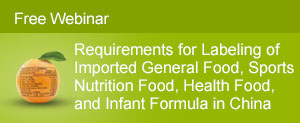17 Sep 2013, The National Health and Family Planning Commission of People’s Republic of China (formerly the Ministry of Health) issued a public notice inviting public comments regarding the clean-up of food-related product standards specially food package materials in China. The notice intends to simplify current food and food-related product standards, to eliminate old and outdated standards and to set up a new standard system. 265 food-related standards including GB 9685 are targeted by the clean-up project.
The notice has made the following proposal:
- 219 of 265 standards are suggested to be eliminated out of food safety national standard system. Most of those standards are industry standards (QB) and SN/T standards such as QB/T 2294-2006 paper cup and SN/T 1880-2007 hygiene standards for imported/exported food packages.
- 36 of 265 standards are suggested to be integrated into new ones. Those standards are current national food safety standards and need to be integrated with other standards to form new ones. For example, the standards for food contact package materials such as PC, PP, PVC, PE, ABS, PS, MF, PVDC, PET material are integrated into a new standard called national standard for resins that can be used as food container and food package materials.
- 9 of 265 standards for all kinds of paints and coatings are suggested to be revised to become a new standard callednational standard for paints and coatings that can be used as food container and food package materials. The content of current standards may be changed substantially.
- 1 of 265 standard QB/T 3531-1999 is suggested to be abolished. The standard on composite flexible packaging material for liquid food has already been covered by other food safety standards.
CIRS’ Comments
The most important proposed change is that China’s positive list of food contact additive GB 9685 will be broken into smaller positive lists according to different materials (i.e, plastics, rubber, adhesives, and inks). New GB standards for food package materials such as plastic, rubber, resins, paint and coating, wood and bamboo, glass, paper, ceramics, enamel, metal, complex material, machine tool, lubricated oli, detergent, sanitizer will be established.
Many foreign FCM additive and end products who wish to enter the Chinese market will be affected by the standard clean-up actions.
Many local FCM products companies that sell end products will need to meet the new standard requirement if those standards are confirmed.
Many foreign FCM additive and end products who wish to enter the Chinese market will be affected by the standard clean-up actions.
Many local FCM products companies that sell end products will need to meet the new standard requirement if those standards are confirmed.
Reference
Background Info and Update History
The Article 32 & 62 of China Food Safety Law prohibits the importation, use or purchase of food-related products (e.g., food additive, food packaging materials) not complying with applicable Chinese Food Safety Standards. The most important food safety standard for food contact additive is GB 9685-2008 Hygienic Standard for Use of Additives in Food Containers and Packaging Materials and it includes 959 approved food contact additives(including monomers) and this standard is regarded as a positive list of food contact additives in China. Food contact additives that are not on the positive list must be approved by health authorities first.
However, when the standard was issued in 2008, it received strong complaints from industry because many other food contact additives that had been approved in EU & USA or proved to be safe were already placed on Chinese market and were not yet included in the standard. To cope with this, the MoH and other ministries jointly issued a circular in 2009 allowing industry to petition by 1 June 2010 the Institute of Nutrition and Food Safety (INFS) for the listing of substances not yet listed on GB9685-2008 or other Chinese standards which are safe for contact use. This is called ‘Grandfathering Process’. As a result of this process, the MOH reviewed submitted petitions, approved more food contact additives and resins in several batches and expanded the positive list from 959 substances to more than 1,500 food contact additives(including MOH notice 2013-32).
More info about food contact regulations and food contact notifications in China, please click here.
However, when the standard was issued in 2008, it received strong complaints from industry because many other food contact additives that had been approved in EU & USA or proved to be safe were already placed on Chinese market and were not yet included in the standard. To cope with this, the MoH and other ministries jointly issued a circular in 2009 allowing industry to petition by 1 June 2010 the Institute of Nutrition and Food Safety (INFS) for the listing of substances not yet listed on GB9685-2008 or other Chinese standards which are safe for contact use. This is called ‘Grandfathering Process’. As a result of this process, the MOH reviewed submitted petitions, approved more food contact additives and resins in several batches and expanded the positive list from 959 substances to more than 1,500 food contact additives(including MOH notice 2013-32).
More info about food contact regulations and food contact notifications in China, please click here.
Contact Us
Ms. Cathy Yu, Senior Consultant, Food Safety Regulation, CIRS China11F Dongguan Building, 288 Qiuyi Road, Binjiang District, Hangzhou, China, 310020
Tel : +86 571 8720 6538 | Fax : +86 571 8720 6533
Email: cathy.yu@cirs-group.com






